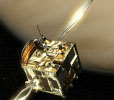Venus Express - PSA
Venus Express

Venus Express (VEX) is investigating the complex dynamics and chemistry of the Venusian atmosphere, and the interactions between the atmosphere and the surface, which will give clues about the characteristics of the surface. VEX will also study the interactions between the atmosphere and the inter-planetary environment (solar wind) to better understand the evolution of the planet. On 09 November 2005 Soyuz-Fregat launcher set Venus Express on its course to Venus from the Russian Baikonur Cosmodrome in Kazakhstan. The spacecraft entered Venusian orbit on 11 April 2006. Data from Venus Express have been available in the PSA since 2008.
Venus Express Orbiter Instruments
ASPERA-4Analyser of Space Plasmas and Energetic Atoms
The scientific objective of the ASPERA-4 experiment is to study the solar wind-atmosphere interaction and characterise the plasma and neutral gas environment in near-Mars space through Energetic Neutral Atom (ENA) imaging and local charged particle measurements. |
MAGMagnetometer
Venus has no detectable internal magnetic field, and the field that exists around the planet is entirely due to the interaction between the solar wind and the atmosphere. MAG will study this process and will help in understanding the effect this has on the atmosphere. |
SPICAVSpectroscopy for Investigation of Characteristics of the Atmosphere of Venus
SPICAV is an imaging spectrometer for ultraviolet and infrared radiation designed to search for water, sulphur compounds and molecular oxygen in the atmosphere and determine the density and temperature of the atmosphere at 80 to 180 kilometers altitude. |
SPICAV-SOIRSPICAV Solar Occultation at Infrared
The SOIR element of SPICAV will investigate the chemistry, structure and dynamics of the Venusian atmosphere as well as vertical profiling of the aeronomic emissions. SOIR uses stellar occultation techniques and a spectrometer with range 2.3 to 4.2 microns. |
VIRTISVisible and Infrared Thermal Imaging Spectrometer
VIRTIS is an imaging spectrometer which allows Venus Express to map details of Venus from the surface to the mesosphere. Scientific objectives cover meteorology of the middle atmosphere, surface mineralogy, aeronomy of the upper atmosphere and a dynamical study of the Venusian atmosphere. |
VMCVenus Monitoring Camera
VMC is a wide-angle multi-channel camera that will take images of the planet in the near infrared, ultraviolet and visible wavelengths. VMC will make global images and will study the cloud dynamics and image the surface. |
VRAVenus Express Radio Science
VRA (sometimes referred to as VeRa) uses the radio link between the spacecraft and Earth to investigate the density, temperature, and pressure of the atmosphere from ~35km up to 100km. The roughness and electrical properties of the surface and the solar wind will also be studied. |
Data Access
Search INTERFACE
Resources
Ancillary Data
General Links
- ESA Portal Mission Page
- ESA SciTech Mission Page
- ESA Cosmos Mission Page
- VEX Legacy Presentations (Oxford)
